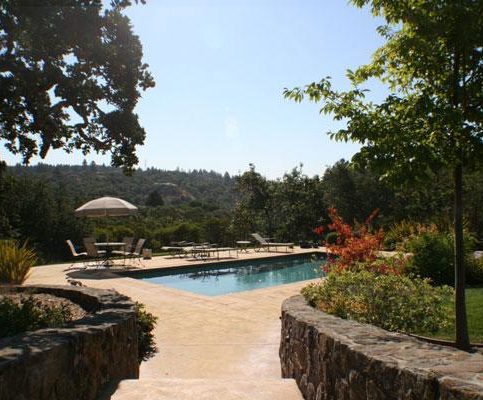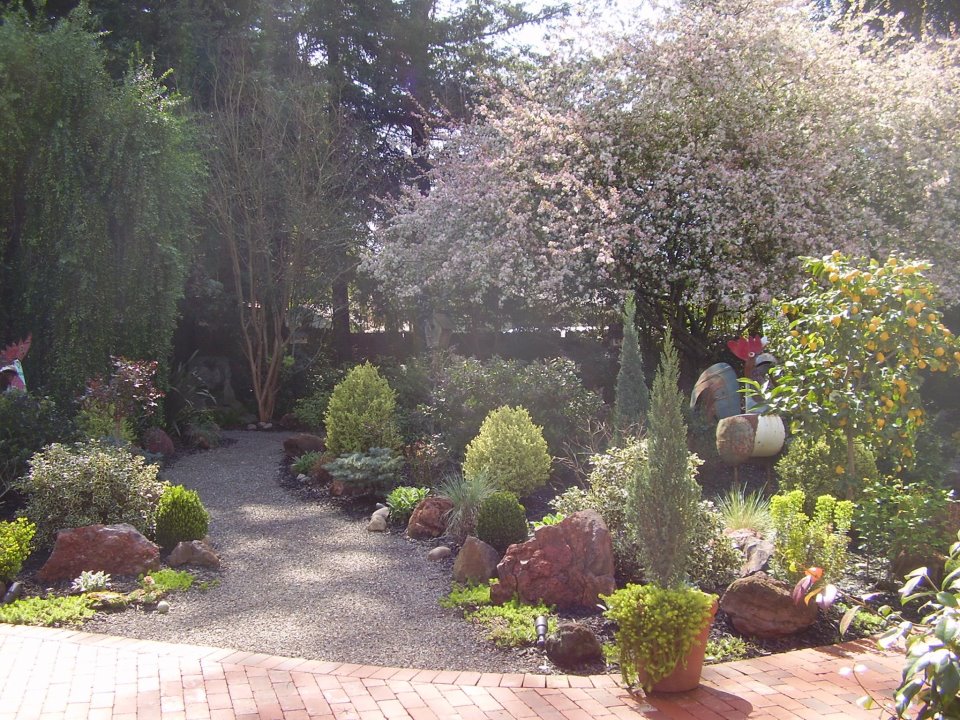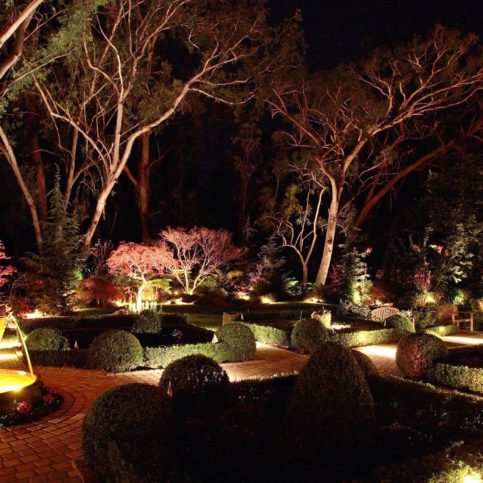
From your garden to your pool, there are several areas where you can improve your exterior efficiency. Photo: Gill Landscape Inc. ©2022
Like many Bay Area homeowners, you’ve probably taken measures to reduce your home’s water and energy usage, such as installing water-saving plumbing fixtures and switching to LED lighting. However, you may have overlooked another part of your property: your yard. From your garden to your pool, there are several areas where you can save water and energy by improving your exterior efficiency. Consider the following measures:
Improve irrigation
If you’re using an outdated sprinkler system to water your lawn and garden, you may be wasting water every day. Traditional sprinkler heads are known for their inefficiency, losing a substantial amount of the water they distribute to wind and sun evaporation. Fortunately, you can easily upgrade your system for a surprisingly low cost. One option is to convert to streamers, which are designed to provide a more direct delivery of water. All you have to do is switch out your old nozzles for streamer nozzles, which cost a little more than $1 apiece.
Another option (if you don’t have a lawn) is to convert your sprinklers to drip irrigation. This is achieved by capping off most of the sprinkler heads and connecting the remaining ones to drip hoses, which are placed throughout the yard. By delivering water directly to plants’ root zones, drip irrigation cuts down on evaporation and helps reduce weeds. Furthermore, a drip system’s emitters can be individually adjusted to custom-regulate water distribution to various areas of a garden.
Go gray
During the recent drought, many conscientious Californians began embracing graywater systems—plumbing modifications that repurpose lightly used water from sinks, bathtubs, and washing machines to irrigate landscape plants and trees. While graywater isn’t potable, it’s safe to use for landscape irrigation as long as certain guidelines are followed. For example, while graywater is fine for watering fruit trees and aboveground crops, it shouldn’t be used to water root vegetables and other crops whose edible portions come into direct contact with irrigation water. Additionally, after installing a graywater system, it’s important to use only “plant-friendly” products for washing dishes and clothes—otherwise, detrimental elements like salt or boron can build up in the soil.
California’s plumbing code has recently been updated to make it easier for homeowners to install graywater systems. Under the current code, “laundry-to-landscape” graywater systems can be installed without a permit as long as 13 guidelines are followed. For the complete list of guidelines, consult California’s graywater code, which is found in Chapter 15 of the California Plumbing Code (CPC). You can also read this summary from Greywater Action.

Drought-tolerant gardens represent an attractive, water-wise alternative to traditional lawns. Photo: Manzanita Landscape Construction, Inc. ©2022
Let go of your lawn
There’s a reason lawns have earned a reputation as “water guzzlers”—most need a minimum of one inch of water per week to stay healthy, which means even a modestly sized lawn will consume a few thousand gallons each year. That’s why, if you’re serious about conserving water on your property, it’s time to consider a landscape makeover. One good option is to install a drought-tolerant garden that features hardscape elements, mulch and native plants that require minimal watering. However, if you’re partial to the look and feel of your lawn, you have another option: synthetic turf. Today’s sophisticated synthetic lawns are virtually indistinguishable from the real thing—the only difference is there’s no watering, mowing or fertilizing required.
Lighten your lighting’s load
Landscape lighting is a great way to enhance your outdoor living space, but if you aren’t careful, it can lead to an unnecessary energy expenditure. To avoid this, make it a point to install low-energy light fixtures. Choices include solar lighting, which uses solar cells to convert sunlight to electricity for powering lights after dark; ENERGY STAR-qualified outdoor light fixtures with automatic daylight shut-offs and motion sensors; and LEDs, which can save up to $50 per year when substituted for incandescent bulbs. With the wide range of low-energy lighting products available today, you can enliven your landscape’s nocturnal ambiance for a negligible expense.

Exterior lighting provides a low-cost way to get more out of your outdoor living space. Photo: Valley Oak Landscaping, Inc. ©2022
Dump your old pool pump
Other than lighting, your yard probably doesn’t consume much energy—that is, unless you have a swimming pool. Between heating and filtration costs, a pool is often the single most expensive energy-consuming fixture on a property, which makes it a prime target for efficiency upgrades. The most impactful measure you can take is to replace your single-speed pool pump (easily the most costly aspect of pool operation) with a variable-speed pump. With a 90 percent increase in energy efficiency, you’ll soon see your power bills take a dive.
Automate ’em all
One of the simplest way to increase your exterior efficiency is to automate your irrigation and outdoor lighting systems. This will allow you to program your irrigation system to run at specific intervals, such as the evening or early morning when there’s less chance for evaporation. Some high-end automation systems even allow you to control the flow and trajectory of individual sprinkler heads. Likewise, you can install a system that allows you to program your exterior lights and even control them from your smartphone. Of course, your pool filter should also have a timer—if not, you should have one installed. By setting all of your yard’s water- and energy-consuming systems to a timer, you can maximize efficiency and minimize waste at all levels.
To find a Diamond Certified company that can help improve your yard’s efficiency, visit www.diamondcertified.info.
